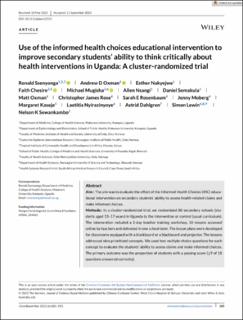| dc.contributor.author | Ssenyonga, Ronald | |
| dc.contributor.author | Oxman, Andrew David | |
| dc.contributor.author | Nakyejwe, Esther | |
| dc.contributor.author | Chesire, Faith Chelagat | |
| dc.contributor.author | Mugisha, Michael | |
| dc.contributor.author | Nsangi, Allen | |
| dc.contributor.author | Semakula, Daniel | |
| dc.contributor.author | Oxman, Matt | |
| dc.contributor.author | Rose, Christopher James | |
| dc.contributor.author | Rosenbaum, Sarah Ellen | |
| dc.contributor.author | Moberg, Jenny Olivia Jenkins | |
| dc.contributor.author | Kaseje, Margaret | |
| dc.contributor.author | Nyirazinyoye, Laetitia | |
| dc.contributor.author | Dahlgren, Astrid | |
| dc.contributor.author | Lewin, Simon Arnold | |
| dc.contributor.author | Sewankambo, Nelson K | |
| dc.date.accessioned | 2023-11-30T08:05:22Z | |
| dc.date.available | 2023-11-30T08:05:22Z | |
| dc.date.created | 2023-10-03T10:08:10Z | |
| dc.date.issued | 2023 | |
| dc.identifier.citation | Journal of Evidence-Based Medicine (JEBM). 2023, 16 (3), 259-413. | en_US |
| dc.identifier.issn | 1756-5383 | |
| dc.identifier.uri | https://hdl.handle.net/11250/3105319 | |
| dc.description.abstract | Aim:: The aim was to evaluate the effect of the Informed Health Choices (IHC) educa-
tional intervention on secondary students’ ability to assess health-related claims and
make informed choices.
Methods:: In a cluster-randomized trial, we randomized 80 secondary schools (stu-
dents aged 13–17 years) in Uganda to the intervention or control (usual curriculum).
The intervention included a 2-day teacher training workshop, 10 lessons accessed
online by teachers and delivered in one school term. The lesson plans were developed
for classrooms equipped with a blackboard or a blackboard and projector. The lessons
addressed nine prioritized concepts. We used two multiple-choice questions for each
concept to evaluate the students’ ability to assess claims and make informed choices.
The primary outcome was the proportion of students with a passing score (≥9 of 18
questions answered correctly).
Results:: Eighty schools consented and were randomly allocated. A total of 2477 stu-
dents in the 40 intervention schools and 2376 students in the 40 control schools
participated in this trial. In the intervention schools, 1364 (55%) of students that com-
pleted the test had a passing score compared with 586 (25%) of students in the control
schools (adjusted difference 33%, 95% CI 26%–39%).
Conclusions:: The IHC secondary school intervention improved students’ ability to
think critically and make informed choices. Well-designed digital resources may
improve access to educational material, even in schools without computers or other
information and communication technology (ICT). This could facilitate scaling-up
use of the resources and help to address inequities associated with limited ICT
access. | en_US |
| dc.language.iso | eng | en_US |
| dc.rights | Attribution-NonCommercial-NoDerivatives 4.0 Internasjonal | * |
| dc.rights.uri | http://creativecommons.org/licenses/by-nc-nd/4.0/deed.no | * |
| dc.title | Use of the informed health choices educational intervention to improve secondary students’ ability to think critically about health interventions in Uganda: A cluster-randomized trial | en_US |
| dc.type | Peer reviewed | en_US |
| dc.type | Journal article | en_US |
| dc.description.version | publishedVersion | en_US |
| cristin.ispublished | true | |
| cristin.fulltext | original | |
| cristin.qualitycode | 1 | |
| dc.identifier.doi | 10.1111/jebm.12553 | |
| dc.identifier.cristin | 2181203 | |
| dc.source.journal | Journal of Evidence-Based Medicine (JEBM) | en_US |
| dc.source.volume | 16 | en_US |
| dc.source.issue | 3 | en_US |
| dc.source.pagenumber | 259-413 | en_US |
| dc.relation.project | Norges forskningsråd: 284683 | en_US |
| dc.relation.project | Norges forskningsråd: 69006 | en_US |

